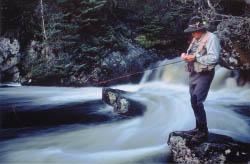The Absolute Beginner
A Fly Fisher's Basic Entomology, Part Two

By Piscator
In our last issue (Winter 2000)
we introduced entomology for the beginning fly fisher with
an explanation of the stages of development of mayflies
and what these mean to the fly fisher. In this issue, we
take a look at the other major order of flies which is
important to fly fishers - caddis flies.
Although they're prolific and constitute a significant
part of a trout's invertebrate diet, caddis flies have been
relatively neglected by fly fishers. Unlike the order of
mayflies, few caddis species have been immortalized with
with popular names. This means that the vast majority
of fly fishers have no common names to refer to each
species (and there are many more species of caddis flies
than mayflies), so the only way we talk about what species
is hatching, we're obligated to describe it - "You know,
that brown mottled caddis about size #14".
CADDIS FLIES (Order Trichoptera)
Nymph
Some caddis flies lay their eggs by fluttering above the water and
depositing them on the surface, after which, they sink to the bottom
and stick there among the gravel, detritus, or weeds. In some species,
the adult fly actually swims to the bottom to deposit the eggs.
After a week or two, the eggs hatch into tiny worm like grubs,
mainly in shades of green, grey, and dirty white. Some species
build protective cases out of gravel or bits of stick. Most of
you have seen these crawling slowly along the bottom. As they
grow bigger, they enlarge the cases. Other species do not build
cases, but hide among the cracks and undersides of structure
on the bottom. Some anchor themselves permanently and build
funnel-shaped nets to catch stream-borne morsels of food. While
trout will pick up the cased species, the others are usually too well
hidden to be readily available as food.
Despite this, fly fishers do catch trout on caddis nymph imitations bumped
along the bottom, not so much because the trout are used to encountering
them, but because they're just being opportunistic.
Pupa
Unlike the mayfly, the caddis has a pupal stage. All species enclose
themselves in some form of pupal case (a chrysalis) anchored to the
bottom, in which the nymph gradually transforms into the pupa.
When the metamorphosis is complete, the case opens, and pupa
emerges, swimming rapidly to the surface. The key workd here is
"rapidly" - in fact, the pupa is literally jet-propelled, squirting
itself up through the water column by ejecting the gases produced
as a by-product of the metamorphosis. As soon as it reaches the surface,
the pupal case splits and the adult fly bursts immediately into flight.
This means that the trout never have the chance to feed leisurely
on hatching caddis flies as they do on hatching mayflies, which
frequently drift downstream drying their wings. When they target
hatching caddis flies, trout have to be quick. You'll often see
a hatching fly erupt from the surface, just millimetres from the
jaws of a fish lunging out of the water after it.
This emergence stage can be very productive for fly fishers. The
basic technique is to cast a weighted nymph upstream, let it drift
naturally along the bottom until it's just downstream, and then
check the drift so that the nymph rises from the bottom - just like
an emerging pupa. This "lift" presentation is more important
than detailed imitation of the natural insect, as trout have little
time to inspect their target closely. Therefore, simple,
impressionistic patterns are usually all you'll need.
Dun

While caddis adults do sometimes drift at rest on the surface of
a stream, they're much more likely to be fluttering about in
the air just above the surface. Unlike mayflies, which mate and
die a day or two after emergance, adult caddis flies can live
for week, returning to the water to deposit eggs at intervals.
You'll see them, especially at dusk, swarming just above the
surface, occassionally dipping into the water. Again, trout
have to be quick to catch them, and their rises will be abrupt
and splashy, unlike the deliberate swirl they make when taking
a drifting mayfly dun.
Afriticials with hair wings and stiff hackle are popular patterns
for imitating fluttering caddis duns, and because the naturals
are moving about on the surface, maintaining a drag-free drift
isn't so critical. In fact, giving the artificial a few twitches
is often a good tactic.
Spinner
Like mayflies, caddis flies die when they're finished mating.
However, because they deposit their eggs over a much longer
period than mayflies, you don't get the same concentrations of
of spent flies on the water. Instead, the spent flies tend
to be mixed in with others which are vigorously fluttering
about. Consequently, there are rarely selective rises to spent
caddis. Nevertheless, some fly fishers do tie and successfully
fish imitations of spent caddis flies, although I suspect
trout take them, not because they're targeting them
specifically, but out of sheer opportunism.
Coming in future issues: stoneflies, midges, and specialised
mayfly variants. ~ Piscator
If you just can't wait until the next issue of the Canadian Fly Fisher,
you will find more on the specific insects in the
Not Quite Entomology section - or Fly Fishing
101.
|

